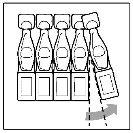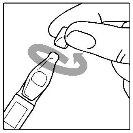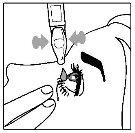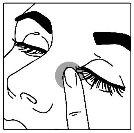
BIMATOPROST/TIMOLOL STADA 0.3 mg/mL + 5 mg/mL eye drops, single-dose containers

How to use BIMATOPROST/TIMOLOL STADA 0.3 mg/mL + 5 mg/mL eye drops, single-dose containers
Introduction
Package Leaflet: Information for the Patient
Bimatoprost/Timolol Stada 0.3 mg/ml + 5 mg/ml eye drops, solution in single-dose container
Read the entire package leaflet carefully before starting to use this medication, as it contains important information for you.
- Keep this package leaflet, as you may need to read it again. If you have any questions, consult your doctor or pharmacist.
- This medication has been prescribed to you only, and you should not give it to others, even if they have the same symptoms as you, as it may harm them.
- If you experience side effects, consult your doctor or pharmacist, even if they are side effects not listed in this package leaflet. See section 4.
Contents of the Package Leaflet
- What is Bimatoprost/Timolol Stada and what is it used for
- What you need to know before starting to use Bimatoprost/Timolol Stada
- How to use Bimatoprost/Timolol Stada
- Possible side effects
- Storage of Bimatoprost/Timolol Stada
- Contents of the pack and further information
1. What is Bimatoprost/Timolol Stada and what is it used for
Bimatoprost/timolol contains two different active substances (bimatoprost and timolol) that reduce high eye pressure. Bimatoprost belongs to a group of medications called prostamides, a prostaglandin analogue. Timolol belongs to a group of medications called beta-blockers.
The eye contains a clear, watery liquid that maintains the inside of the eye. This liquid is continuously drained from the eye and new liquid is generated to replace it. If the liquid does not drain quickly enough, the pressure inside the eye increases, and in the long run, your vision could be damaged (a disease called glaucoma). This medication works by reducing the production of liquid and also increasing the amount of liquid that is drained. This reduces the pressure inside the eye.
Bimatoprost/timolol eye drops are used to treat high eye pressure in adults, including the elderly. This high pressure can cause glaucoma. Your doctor will prescribe this medication if other eye drops containing beta-blockers or prostaglandin analogues have not been effective enough on their own.
2. What you need to know before starting to use Bimatoprost/Timolol Stada
DO NOT use Bimatoprost/Timolol Stada
- if you are allergic to bimatoprost, timolol, beta-blockers, or any of the other ingredients of this medication (listed in section 6).
- if you currently have or have had respiratory problems, such as asthma and/or chronic obstructive pulmonary disease (a severe lung disease that can cause wheezing, difficulty breathing, and/or persistent cough) or other types of respiratory problems.
- if you have heart problems, such as low heart rate, heart block, or heart failure.
Warnings and precautions
Consult your doctor or pharmacist before starting to use bimatoprost/timolol if you have or have had:
- coronary heart disease (symptoms may include chest pain or tightness, difficulty breathing, or a feeling of suffocation), heart failure, low blood pressure;
- changes in heart rate, such as low heart rate;
- respiratory problems, asthma, or chronic obstructive pulmonary disease;
- circulatory disorders (such as Raynaud's disease or Raynaud's syndrome);
- overactive thyroid gland, as timolol can mask the signs and symptoms of thyroid disease;
- diabetes, as timolol can mask the signs and symptoms of hypoglycemia;
- severe allergic reactions;
- liver or kidney problems;
- surface eye problems;
- separation of one of the layers of the inside of the eyeball after surgery to reduce eye pressure;
- known risk factors for macular edema (inflammation of the retina that causes vision deterioration), such as cataract surgery.
Inform your doctor before undergoing surgical anesthesia that you are using bimatoprost/timolol, as timolol can alter the effects of some medications used during anesthesia.
During treatment, this medication may cause fat loss around the eye, which can cause deepening of the palpebral sulcus, sunken eyes (enophthalmos), drooping eyelids (ptosis), stretching of the skin around the eye (involution of dermatocalasis), and the white part of the eye becomes more visible (inferior scleral exposure). The changes are usually mild, but if they worsen, they can affect your field of vision. The changes may disappear if you stop using bimatoprost/timolol. This medication can also cause darkening and growth of eyelashes, as well as darkening of the skin around the eyelid. The color of the iris may darken. These changes may be permanent and more noticeable if only one eye is being treated. It can also cause hair growth in contact with the skin surface.
Children and adolescents
This medication should not be used in children and adolescents under 18 years of age.
Other medications and Bimatoprost/Timolol Stada
This medication may affect or be affected by other medications you are using, including other eye drops for the treatment of glaucoma. Inform your doctor or pharmacist if you are using, have recently used, or may need to use any other medication. Inform your doctor if you are using or plan to use medications to lower blood pressure, for the heart, for diabetes treatment, quinidine (used to treat heart conditions and some types of malaria), or for depression treatment, known as fluoxetine and paroxetine.
Pregnancy and breastfeeding
If you are pregnant or breastfeeding, think you may be pregnant, or plan to become pregnant, consult your doctor or pharmacist before using this medication. Do not use bimatoprost/timolol if you are pregnant unless your doctor recommends it.
Do not use this medication if you are breastfeeding. Timolol can pass into breast milk. Consult your doctor before using any medication during breastfeeding.
Driving and using machines
This medication may cause blurred vision in some patients. Do not drive or use machines until the symptoms have disappeared.
Bimatoprost/Timolol Stada contains phosphates
This medication contains 0.96 mg of phosphates in each ml of solution.
If you have severe damage to the transparent layer of the front of the eye (the cornea), treatment with phosphates, in very rare cases, can cause cloudy patches on the cornea due to calcium accumulation.
3. How to use Bimatoprost/Timolol Stada
Follow the administration instructions of this medication exactly as indicated by your doctor or pharmacist. If you are unsure, consult your doctor or pharmacist again.
The recommended dose is one drop administered once a day, either in the morning or at night, in each eye that needs treatment. Use this medication every day at the same time.
Instructions for use
Wash your hands before using this medication. Make sure the single-dose container is intact before use. The solution should be used immediately after opening the container. To avoid contamination, do not allow the open end of the single-dose container to touch your eye or any other surface.




Image 1 Image 2 Image 3 Image 4
- Separate the single-dose container from the strip (image 1).
- Hold the single-dose container in a vertical position (with the cap facing up) and unscrew the cap (image 2).
- Gently pull down the lower eyelid to form a pocket. Turn the single-dose container upside down and squeeze it to release 1 drop into the affected eye(s) (image 3).
- While keeping the eye closed, press the lacrimal sac of the eye (the area where the eye meets the nose) with your finger and maintain the pressure for 2 minutes (image 4). This helps prevent bimatoprost/timolol from reaching the rest of the body.
- Discard the single-dose container after use, even if there is still solution inside.
If the drop falls outside the eye, try again. Clean any excess that runs down the cheek.
Contact lenses
If you wear contact lenses, remove them before using this medication. Wait 15 minutes before putting your contact lenses back in.
Other medications and Bimatoprost/Timolol Stada
If you use bimatoprost/timolol with another eye medication, wait at least 5 minutes between administering this medication and the other medication. Use any eye ointment or gel last.
If you use more Bimatoprost/Timolol Stada than you should
If you use more than you should, it is unlikely to cause you any serious harm. Apply the next dose at the usual time. If you are concerned, talk to your doctor or pharmacist.
In case of overdose or accidental ingestion, consult your doctor or pharmacist immediately or call the Toxicology Information Service, phone 91 562 04 20, indicating the medication and the amount ingested.
If you forget to use Bimatoprost/Timolol Stada
Apply one drop as soon as you remember and then return to your usual routine. Do not apply a double dose to make up for missed doses.
If you stop using Bimatoprost/Timolol Stada
Bimatoprost/timolol should be used every day for it to work properly.
If you have any other questions about using this medication, ask your doctor, pharmacist, or nurse.
4. Possible side effects
Like all medications, this medication can cause side effects, although not everyone gets them. You can usually continue using the eye drops, unless the effects are serious. If you are concerned, talk to your doctor or pharmacist. You should not stop using this medication without talking to your doctor.
The following side effects have been observed with bimatoprost/timolol.
Very common side effects(may affect more than 1 in 10 people)
Affecting the eye
Redness. Fat loss in the eye area that can cause deepening of the palpebral sulcus, sunken eyes (enophthalmos), drooping eyelids (ptosis), stretching of the skin around the eye (involution of dermatocalasis), and the white part of the eye becomes more visible (inferior scleral exposure).
Common side effects(may affect up to 1 in 10 people)
Affecting the eye
Burning, itching, stinging, conjunctival irritation (the transparent layer of the eye), sensitivity to light, eye pain, sticky eyes, dry eyes, feeling of having something in the eye, small erosions on the surface of the eye with or without inflammation, difficulty seeing clearly, redness and itching of the eyelids, eyelash growth, darkening of the eyelids, darker color around the eyes, headache, longer eyelashes, eye irritation, watery eyes, inflamed eyelids, reduced vision.
Affecting other parts of the body
Runny nose, headache.
Uncommon side effects(may affect up to 1 in 100 people)
Affecting the eye
Abnormal sensation in the eye, iris inflammation, conjunctivitis (inflammation of the transparent layer of the eye), painful eyelids, tired eyes, eyelashes growing inward, darkening of the iris color, sunken eyes, drooping eyelid, retracted eyelid (away from the eye surface, causing incomplete closure of the eyelids), tightness of the eyelid skin, darkening of the eyelashes.
Affecting other parts of the body
Shortness of breath.
Frequency not known(cannot be estimated from the available data)
Affecting the eye
Cystoid macular edema (inflammation of the retina that causes vision deterioration), eye inflammation, blurred vision, eye discomfort.
Affecting other parts of the body
Difficulty breathing/wheezing (production of sounds when breathing), symptoms of allergic reaction (swelling, redness of the eye, and skin rash), changes in taste, dizziness, decreased heart rate, high blood pressure, sleep disturbances, nightmares, asthma, hair loss, skin discoloration (periorbital), fatigue.
As the following additional side effects have been seen in patients using timolol or bimatoprost eye drops, it is possible that they may occur with this medication. Like other eye medications, timolol is absorbed into the bloodstream. This can cause side effects similar to those observed with intravenous or oral beta-blockers. The likelihood of experiencing side effects with eye drop use is lower than when medications are taken orally or injected. Among the side effects listed are those observed with bimatoprost and timolol when used to treat eye conditions:
- Severe allergic reactions with inflammation and difficulty breathing that can be potentially life-threatening.
- Hypoglycemia.
- Depression; memory loss; hallucination.
- Fainting; stroke; decreased blood flow to the brain; worsening of myasthenia gravis (increased muscle weakness); sensation of tingling.
- Decreased sensitivity on the eye surface; double vision; ptosis; separation of one of the layers of the eyeball after surgery to reduce eye pressure; inflammation of the eye surface, hemorrhage in the back of the eye (retinal hemorrhage), inflammation inside the eye, increased blinking.
- Heart failure; irregularities or interruption of heartbeat; bradycardia or tachycardia, excess fluid, mainly water, that accumulates in the body; chest pain.
- Low blood pressure; swelling or coldness of the hands, feet, and extremities, caused by constriction of blood vessels.
- Cough, worsening of asthma, worsening of chronic obstructive pulmonary disease (COPD).
- Diarrhea; stomach pain; nausea and vomiting; indigestion; dry mouth.
- Scaly red patches on the skin; skin rash.
- Muscle pain.
- Decreased sexual desire, sexual dysfunction.
- Weakness.
- Increased results of some blood tests that indicate how the liver is working.
Other side effects reported with phosphate-containing eye drops
This medication contains 0.38 mg of phosphates in each 0.4 ml of solution, equivalent to 0.96 mg/ml. If you have severe damage to the transparent layer of the front of the eye (the cornea), treatment with phosphates, in very rare cases, can cause cloudy patches on the cornea due to calcium accumulation.
Reporting side effects
If you experience any side effects, consult your doctor or pharmacist, even if they are side effects not listed in this package leaflet. You can also report them directly through the Spanish Medication Surveillance System for Human Use: https://www.notificaram.es. By reporting side effects, you can help provide more information on the safety of this medication.
5. Storage of Bimatoprost/Timolol Stada
Keep this medication out of the sight and reach of children.
Do not use this medication after the expiration date stated on the container after "EXP". The expiration date refers to the last day of the month indicated.
This medication is for single use and does not contain preservatives. Do not store the unused solution.
This medication does not require any special storage temperature. Store the single-dose containers in the bag and in the box to protect them from light. After opening the single-dose container, the product must be used immediately. Once the bag is opened, use within 7 days.
Medications should not be disposed of through wastewater or household waste. Deposit the containers and medications you no longer need in the SIGRE collection point at your pharmacy. Ask your pharmacist how to dispose of the containers and medications you no longer need. This will help protect the environment.
6. Packaging Content and Additional Information
Composition of Bimatoprost/Timolol Stada
- The active ingredients are bimatoprost 0.3 mg/ml and timolol 5 mg/ml, corresponding to 6.8 mg/ml of timolol maleate.
- The other components are sodium chloride, sodium hydrogen phosphate heptahydrate, citric acid monohydrate, and water for injectable preparations. Small amounts of hydrochloric acid or sodium hydroxide may be added to adjust the solution to the correct pH (acidity) level.
Appearance of the Product and Packaging Content
Bimatoprost/timolol Stada is a clear and colorless solution presented in single-dose plastic containers, each containing 0.4 ml of solution.
The containers are packaged in 6 aluminum bags, each containing 5 single-dose containers, for a total of 30 single-dose containers.
Marketing Authorization Holder and Manufacturer
Marketing Authorization Holder
Laboratory STADA, S.L.Frederic Mompou, 5
08960 Sant Just Desvern (Barcelona)
Spain
info@stada.es
Manufacturer
Genetic S.p.A.
Nucleo Industriale, Contrada Canfora
84084 Fisciano (SA)
Italy
or
STADA Arzneimittel AG
Stadastrasse 2 – 18
61118 Bad Vilbel
Germany
Date of the Last Revision of this Prospectus: October 2024
Detailed information on this medication is available on the website of the Spanish Agency for Medicines and Health Products (AEMPS)
http://www.aemps.gob.es/
- Country of registration
- Active substance
- Prescription requiredYes
- Manufacturer
- CompositionCLORURO DE SODIO (6,80 mg mg), HIDROGENOFOSFATO DE SODIO HEPTAHIDRATO (2,68 mg mg), HIDROXIDO DE SODIO (E 524) (c.s.p 7,1 - 7.5 pH mg)
- This information is for reference only and does not constitute medical advice. Always consult a licensed doctor before taking any medication. Oladoctor is not responsible for medical decisions based on this content.
- Alternatives to BIMATOPROST/TIMOLOL STADA 0.3 mg/mL + 5 mg/mL eye drops, single-dose containersDosage form: EYEDROP, 10 mg/ml + 5 mg/mlActive substance: timolol, combinationsManufacturer: Novartis Europharm LimitedPrescription requiredDosage form: EYEDROP, 0.3 mg/ml + 5 mg/mlActive substance: timolol, combinationsManufacturer: Brill Pharma S.L.Prescription requiredDosage form: EYE DROP, 0.3 mg/ml + 5 mg/mlActive substance: timolol, combinationsManufacturer: Zentiva K.S.Prescription required




